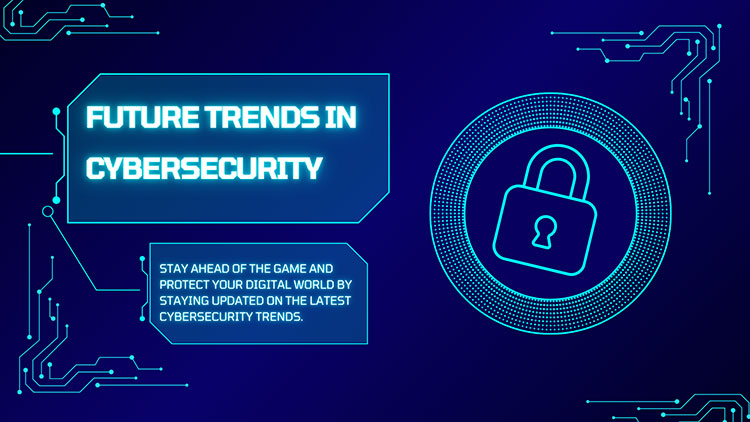Future Trends in Cybersecurity

July 31, 2024
SEB Marketing Team
Cyber threats continue to increase in sophistication and frequency. For organizations of all sizes, this offers an exiting opportunity to innovate and adapt with new technologies emerging to meet cybersecurity needs. Looking ahead, several key trends are poised to revolutionize the industry. Here are some of the top future trends that will shape the future of cybersecurity:
Remote Work and Secure Access: With more employees accessing corporate networks from home, there is a greater need for robust security measures and cyber awareness. Future trends will focus on ensuring a secure connection using technology such as enhanced VPNs. Virtual Private Networks (VPN)s are invaluable for remote employees as they ensure safe access through an encrypted connection to the company’s network.
AI-Driven Threat Detection and Response: As cyber attacks are increasingly more sophisticated; the use of Artificial Intelligence (AI) and Machine Learning (ML) are becoming important players in cybersecurity. These technologies can quickly analyze vast amounts of data with algorithms that detect anomalies, identify potential threats, and respond to incidents in real-time. Advanced AI-driven tools will continue to enhance threat detection, predictive analytics, and automated response systems to protect security systems and prevent the theft of sensitive data.
Quantum Resistant Encryption: Quantum computing is an advanced computing paradigm that utilizes the principles of quantum mechanics to process information exponentially faster than classical computers by leveraging quantum bits (qubits) that can exist in multiple states simultaneously. While quantum computers offer incredible processing power, they are also a concern, because they could potentially break current encryption algorithms. This could lead to exposing sensitive data and render current security measures obsolete. The industry is gearing up for post-quantum cryptography to develop new encryption techniques that can withstand quantum attacks.
Sophisticated Phishing Attacks: Phishing attacks while common, continue to evolve. Many companies already employ cyber security practices but, with leveraging social engineering and AI to craft highly convincing emails and messages, modern phishing attacks are becoming harder to recognize as they are increasingly more personalized. Future cybersecurity measures will focus on advanced phishing detection systems, employee training, and AI-based email filtering to combat these evolving threats.
Zero Trust Security Model: This security model assumes that threats can exist both inside and outside the network so continuous verification of user identity from every access request regardless of its location minimizes the risk of internal threats. This might include Multi-Factor Authentication (MFA) or granting users and devices limited access. Adoption of zero-trust principles will be a major trend in cybersecurity strategies.
DevOps (DevSecOps) Integration: DevOps integration is a holistic approach that aligns development and operations teams to improve collaboration, automate processes, and enhance the overall efficiency and quality of software delivery. As organizations increasingly adopt DevOps practices for project management, integrating security into the development process becomes crucial. Future trends involve making sure that security is built into every stage of creating software, which helps keep applications safer and speeds up how quickly any security problems can be resolved.
Internet of Things (IoT) Security: The Internet of Things (IoT) introduces numerous security challenges due to the sheer number of connected devices. Nearly every single device, ranging from household appliances to wearable gadgets and industrial machines can communicate with each other, thereby transferring data. The sheer number of potentially insecure devices in use creates many points of entry for attackers. Future trends will include enhanced IoT security protocols, device authentication, and network segmentation to protect against IoT-based threats.
As cybersecurity is constantly changing, it’s important for IT Professionals to keep up with new developments. By staying informed about these changes, organizations can better protect themselves from new threats. Key strategies like using artificial intelligence and machine learning, handling remote work challenges, getting ready for quantum computing, and adopting strict security measures will shape how we stay safe in the future.
For additional information on IT Security Solutions, check out resources from QLogitek, an SEB company.
Post navigation
Related Posts

3 Keys to Sustainable Excellence of High-Performance Teams
You spent a considerable amount of capital and time hiring the best engineers, the most…

Your 5-Point Generative AI Policy Checklist for HR and Tech Leaders.
It’s official: Generative AI (GenAI) is no longer a futuristic concept—it’s a powerful productivity co-pilot…

The Psychological Safety Re-Check: Why Even Top Teams Need a Periodic Vulnerability Audit
You’ve built a rockstar team. They hit their numbers and they crush their goals. Congratulations!…
